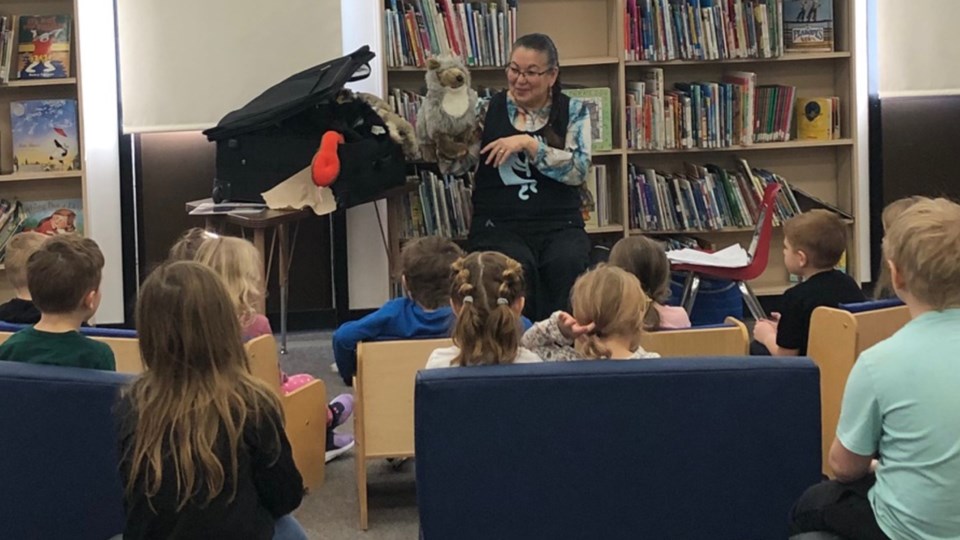NIPAWIN — Sharon Meyer is the First Nations and Métis Education Consultant with the North East School Division and as part of her role, she will brings Indigenous storytelling to students in over 20 schools.
The Province of Saskatchewan declared the month of February 2023 to be Saskatchewan Aboriginal Storytelling Month in the province. For Indigenous people, storytelling is both a gift and a very old custom, sanctioned by the people to teach, entertain and remember.
Meyer said that February is also called eagle moon (Mikisowipîsim in Cree). It is where traditionally the First Nation peoples would crest regalia with the eagle feather, such as headdresses, eagle staff and other ceremonial pieces. This is where the eagles start to lay their eggs, so it’s a very specific month to the Indigenous culture. The eagle moon is also known for rest time. This time gave Indigenous peoples time to sit and share stories.
First Nations are connected to Mother Earth and that is where all the stories and legends come from, Meyer said. The original stories involve the trickster, a being that existed with the plants and animals before the coming of humans. The trickster that Meyer was raised with in the Cree culture was “Wesakechak”. All First Nations have a trickster. The name changes in different nations but the stories are similar.
“That is why the Indigenous people are so connected to our stories and the lessons to be learned from them,” Meyer said. “Every traditional legend is connected to a lesson of how we should be in relation to the plants and animals. She said we have kinship to Mother Earth, and when you have kinship we celebrate, and learn how to respect each other through our legends and that is why we have legends.”
Meyer said the NESD is large and she can’t be everywhere at once, so she created a website called Kôhkum's Gathering. There you will find recordings of mainly videos that are curriculum-based teachings. There are storytelling videos of 13 legends that are available, the teachers can go into the videos and use this media to teach curriculum-based lessons. She works with the teachers to create online stories, and it is all available for teachers to use and share with other school divisions. Kôhkum’s Gathering has gained popularity throughout the Prairie Provinces and all over Canada among teachers and other educational institutions.
“When I share my legends, I make sure the children know which nation I received the story from,” Meyer said.
When she introduces herself she always says, “I’m from the Beardy’s and Okemasis Cree Nation. “
Using a globe, with Turtle Island (the continent of North America) drawn on it, she points out which nation her stories originate from. This helps kids can understand where the stories are coming from, teaches connections with the stories and brings them to a mindful place. She uses puppets and pictures, to keep the children engaged and said a good storyteller will bless the imagination of a child and bring them so they can picture the place they could be standing at, like a lake, or river or forest. She utilizes puppets and other media to capture the attention of students. A good story can be unique and also have a personal connection, Meyer said.
“We are in an era where reconciliation has opened up the earnest to learn the truth, understand our history and move beyond colonial thoughts and acts,” Meyers said. “It’s a beautiful time to be first nation, because people are open to listening and learning.”
Meyers also highlighted that the NESD has also partnered with Dr. Verna St. Denis and have a MOU for a piece of land at Love, for land based teachings for schools. This just started in May of last year, with 380 students attending so far. Everything is linked to the curriculum but from a First Nation and Métis perspective, the kids learn about medicines, travois and have travois races. It is all put together by materials from nature. Students make arbor stands with no nails or hammers used, they learn how to set up a teepee. Students are able to take in the land and gain a new perspective when learning in Love.
Meyers will be in Tisdale, Naicam and Melfort schools for storytelling month. She also does online sessions through the Office of Treaty Commissioner across Saskatchewan in February.
When asked if older students are engaged and enjoy the storytelling, Meyers said, “it rekindles them back to their childhood, and we are trying to train them to be adults, but we can’t forget that there is a child in all of us, it brings the child out of everyone.”




